Pandemic Legacy – Write Your Own Legacy in This Campaign-Style Cooperative Board Game

Pandemic Legacy, designed by Matt Leacock and Rob Daviau, is scheduled to hit game stores worldwide October 8. Each group of gamers that plays the game will write their own Pandemic Legacy as the game unfolds, campaign-style, in literally unique ways based on how each session ends. Because Pandemic, with the On The Brink Expansion, is my favorite cooperative game, I’ve been avidly following all information released about it. Following is a summary of the most interesting tidbits I’ve found. Don’t worry, there aren’t any spoilers. The designers and publisher have been quite careful not to leak any details that could ruin the surprises in store for us.
Background
Pandemic Legacy, a stand-alone game, is based on the hit cooperative game Pandemic and Risk: Legacy – a ground-breaking spin-off of Risk that introduced the Legacy mechanic to board games. The Legacy mechanic brings campaign-style play to board games, that is, the results of each play session directly affect the next play session in myriad ways: the game, its components and even the rulebook change accordingly.
Characters – You Might Improve Your Skills, Be Scarred or Even Die!
In Pandemic Legacy, your valiant scientists see all kinds of awful things while they put themselves in harm’s way to treat diseases and work hard to find cures for the quickly-spreading diseases. People panic, riot and worse and your scientists are in the middle of the fray. It’s no wonder some can’t sleep at night or might feel a little intimidated about entering a city on the brink of chaos. Being in a city when an Outbreak occurs is one way a scar effect could be tripped. Two types of scars mentioned by Rob Daviau in Game Trade Magazine (GTM) #186 are:
- INTIMIDATED: Spend one additional action every time you Treat Disease in a city that is rioting.
- INSOMNIAC: Reduce your hand limit by one (1) card.
Fortunately, the designers (Thank you, Matt) were kind enough to let you choose your scar, so you can make sure you’re not afflicted by a scar that would be devastating to your Role. For instance, if you’re the Medic you wouldn’t want to be Intimidated and the Researcher wouldn’t want to be an Insomniac. Each character can have two scars, a third one however…
Characters can become Lost, that is gone, dead, “Hasta la vista, baby.” This can happen if a character is in a city when it falls or if he gains a third scar. Entering a city with three cubes when you have two scars or the city is about to collapse presents a big risk. Being a hero, you might take the chance and cross your fingers the city doesn’t Outbreak.
Don’t worry, if your character dies, er is Lost, you’re not out of the game. You’ll take on the role of a Civilian, without any special powers, and continue the good fight against the impending pandemic.
While you survive, your character may receive upgrades. Upgrades represent training and/or experience you’ve acquired in your fight to save the world. Note that I keep using the term Character instead of Role. In Pandemic Legacy, you’ll give your Character a name and she’ll evolve, like a character in a roleplaying game, and even develop Relationships that link her to other Characters.
Cities Sliding Into Chaos – What Happened to Los Angeles?
One of the designers’ goals for Pandemic Legacy was to “amplify the narrative” and create the feeling of “a world sliding into chaos.” To accomplish this, they gave each City a Panic Level. Every time a city Outbreaks, its Panic Level increases by one. As the City’s populace panics, it becomes harder to deal with, harder to enter, etc. Here are the Panic Levels and their effects as described by Rob Daviau in GTM #186:
- Panic Level 0: “Stable” – No effect. All cities start stable.
- Panic Level 1: “Unstable” – No effect. Each city can absorb one outbreak without any effect. Consider the first outbreak a fair warning.
- Panic Level 2-3: “Rioting” – Now we’re getting somewhere. No direct or charter flights can be used in or out of this city. Any research station in the city is destroyed and cannot be rebuilt. Since this city is now only driveable, it is harder to get to. It adds a touch of static into the system. Of course, if you have a lot of rioting cities in a region, then the whole region gets tricky to treat.
- Panic Level 4: “Collapsing” – Now you have to discard one card of the city’s color to drive/ferry into this city. So in addition to the penalty for rioting, you now lose a card to go in there.
- Panic Level 5: “Fallen” – Now you discard an additional card of the city’s color to enter the city (for a total of two cards). Really just a higher cost than Collapsing but quite an effort to just get to a city, let alone be effective in it. Not to mention how valuable cards are.
Funding – Adjusting the Difficulty As The Campaign Unfolds
Anyone who’s ever played Pandemic has experienced it: that game where everything goes to hell in a hand-basket from the get-go. The setup is tough enough, then every card draw just enhances the evil you’re facing. Some players immediately throw in the towel, while others muddle through, sometimes even prevailing. In a regular Pandemic game, it’s no big deal. Laugh it off and try again. But what happens if you get the hand-basket in a Legacy game?
Well, luckily the designers thought about that and came up with the Funding rule. In regular Pandemic, the Player Deck has five Special Event cards or two per player when playing with On The Brink. Special Events are powerfully useful cards. Without their special effects, which you can execute when you most need them, the game would be much more difficult and end five or more cards quicker. The Funding rule in Pandemic Legacy leverages that game-changing effect. At the beginning of each game, players will add a number of Special Events to the Player Deck equal to their current Funding Level. (You even get to choose which Special Events you want to include in the Player Deck after seeding the board with the initial infection cubes.) Game 1 begins with a Funding Level of 4, so you get to add 4 of the 8 possible Special Event cards to the Player Deck.
If you win the game, then clearly you don’t need as much help, so the government cuts your funding by two. If you lose, the government sees that you need more help and increases your funding by 2. The lowest your funding can go is 0, the highest is 10. Wait, didn’t I just say there were 8 possible Special Events? Well, there are… to begin with. As the campaign progresses, more Special Events will become available.
Should Funding not be enough and you experience a particularly bad streak of luck, there’s a sealed packet that reads, “Open if you lose four games in a row.” It serves two purposes: 1) help from the game should you really, really need it and 2) it gives you a psychological boost. The designers say playtest groups, after losing their third game in a row, would point to the packet saying, “Well, we’re probably OK since we haven’t lost four in a row yet.” If you do, there’s always that packet of help.
The Legacy Deck
The Legacy Deck is the heart of the campaign-style play of Pandemic Legacy. Note the red warning text on the back of the card: “Do not draw, reveal, look at, handle, or otherwise disturb these cards until instructed.” The cards are numbered (bottom right corner), so if you drop them, you can put them back in order – don’t peek, though – you don’t want to spoil the surprise.
The back of the cards tell you when to draw them. For example, the first card of the Legacy Deck says, “Draw this card and read the other side just before you set up your first game.” After drawing, reading and executing this card, you may be instructed to draw and resolve additional cards until you reach the next Stop sign. According to W. Eric Martin of Board Game Geek fame who’s played the first three months of the campaign, “Sometimes these cards are helpful, but that doesn’t happen often.”
As you play, you’ll modify the game board, character sheets and even rulebook with stickers. You’ll be able to see some of the stickers for possible rewards, scars and tagging city status when you first open the box. The rest of the stickers and other things are hidden in packets that you should only open when directed by the Legacy deck. An example of a possible reward is an Unfunded Event sticker that you can apply to any City card in the Player Deck. In future games, that card can be used as a normal City card or played as a free-action Special Event. I wonder what the spot in the top right corner is for?
Scope
“One year. One team. One hope.” That’s how Z-Man Games introduced Pandemic Legacy in a July 2014 announcement. Each Pandemic: Legacy game is designed to run thematically over a year (game time, not real time), which translates to 12 – 24 plays. You start in January and work from there. If you lose a game, you can play that month’s setup/scenario again. Win or lose the second time, you move on to the next month to keep the game moving along.
According to Matt Leacock, “No knowledge of the expansions is needed! You’ll be able to jump right in if you’ve played the base game before a few times. Rules for playing the base game are included in the box as well, so it’s fully self-contained.”
Game play is, at first, the same as standard Pandemic, though you’ll find more connections between cities on the board. As you play, new rules will be gradually added to construct the ongoing thematic story.
When asked how card exchanges would work in Pandemic Legacy, Rob Daviau answered, “The game uses the standard Pandemic rules for card swapping. But we’ve got other surprises for you as you play.” Hmm, intriguing.
Z-Man Games is releasing Pandemic Legacy – Season 1 in two different box designs, one red, one blue, so people wanting to play Pandemic Legacy with two different groups can tell their games apart. The contents of both boxes are identical – until you begin writing your own legacy, that is. According to Matt Leacock: “There’s no difference other than the cover design. Pick up the one you like more or if you’re playing with multiple groups, use the covers to help differentiate the sets.”
Wait, “Season 1?” Sorry, no information has been released on that – that I can find – except Rob’s answer, “The plan is entirely new” when asked whether Season 2 would add to the Season 1 board or be a new box with a new board, etc.
Yes, the MSRP of Pandemic Legacy is higher than regular Pandemic, $69.99 vs. $39.99. Why? Well, there’s a lot more stuff in the box. When you compare the price to other forms of entertainment, it’s still quite cost-effective. For example, it would cost $180 for just two people to go to the movies 12 times (minimum number of guaranteed Pandemic Legacy plays) calculated at matinée prices ($7.50 each x 2 tickets x 12 visits), double that for four people or non-matinée showtimes. You’ll get at least 12 plays from Pandemic Legacy and likely many more, making it a much more cost-effective entertainment bang for the buck.
What Happens When I’ve Played the Entire Campaign?
In Risk: Legacy, once you’ve played through the entire campaign, you’re left with a unique game you can continue to play. What happens when you completed the Pandemic Legacy campaign is still quite hush, hush. All co-designer Rob Daviau will say is, “The end state is a bit of a surprise.”
Pandemic Legacy supports 2-4 players ages 13 and up with an estimated playtime of 60 minutes per game. The campaign-style play is designed for 12 to 24 games. Pandemic Legacy will debut in 10 languages around the world on Thursday, October 8, 2015. Preorder your copy now from Here Be Books & Games.
Copyright © 2015 by Tina G. McDuffie. All rights reserved.
Photo rights retained by their respective copyright holders.


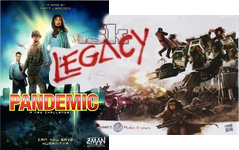
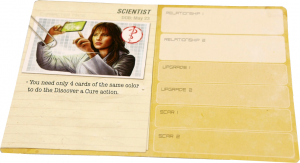
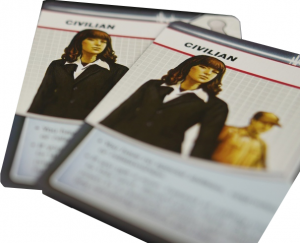

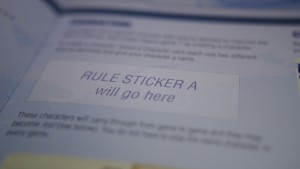

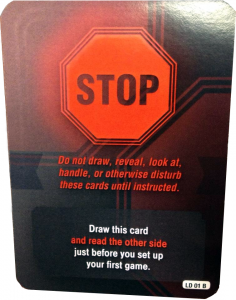
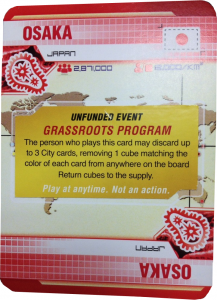
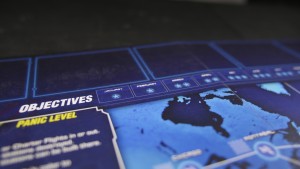

Pingback: Pandemic: Legacy January Session Report - Redacted (Spoilers Hidden) - The Glass Meeple
Pingback: Pandemic Legacy game review - The Glass Meeple